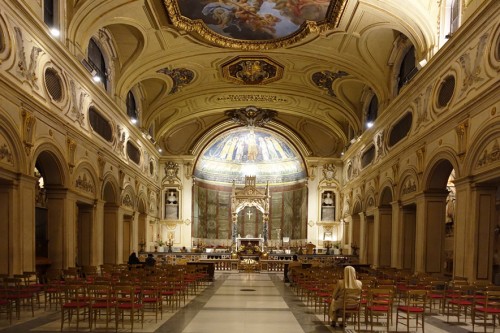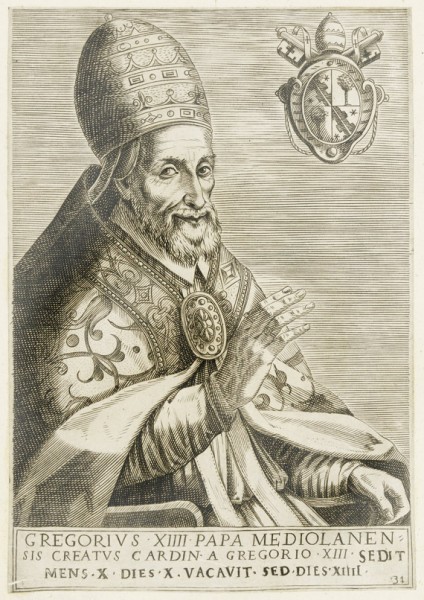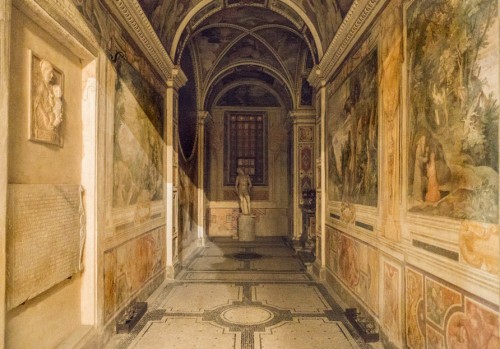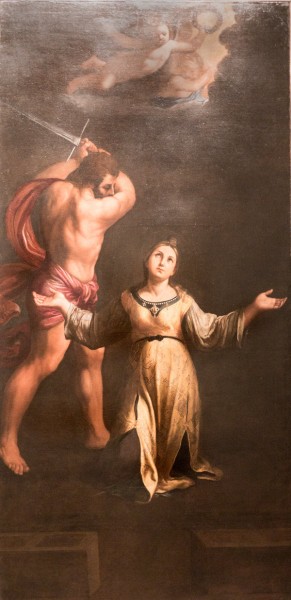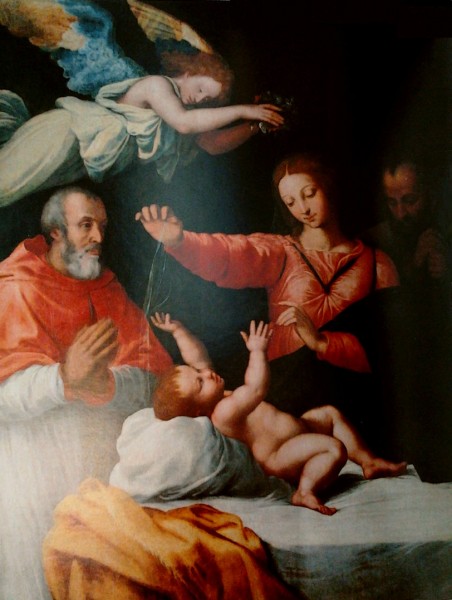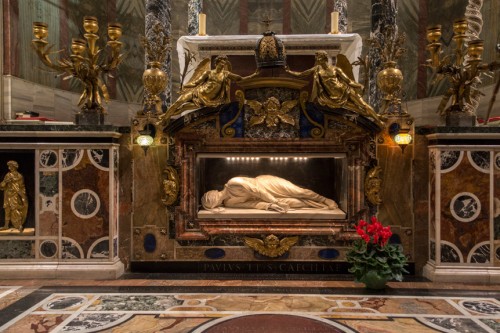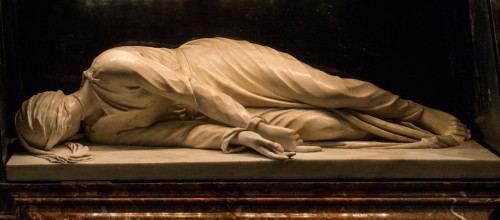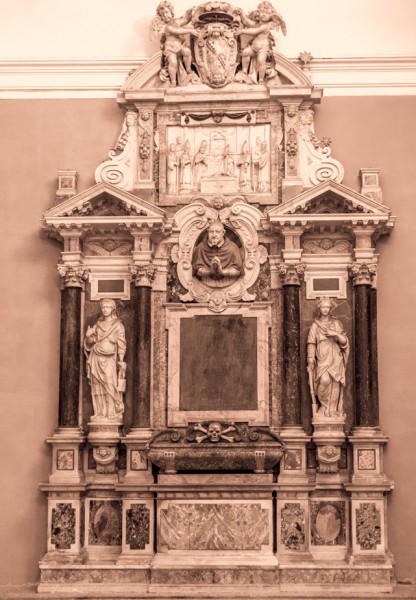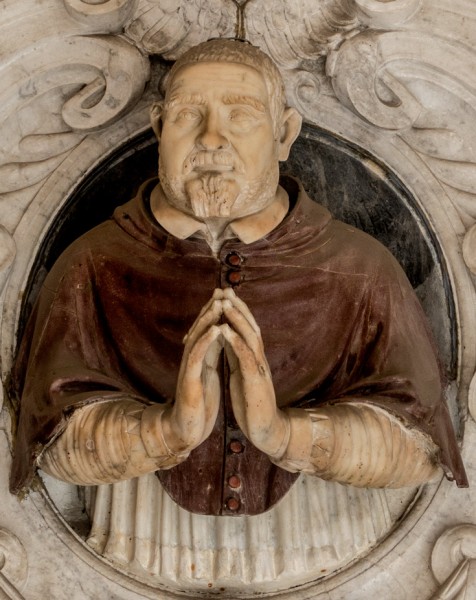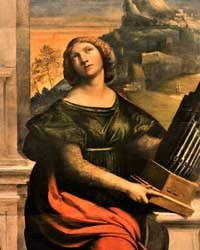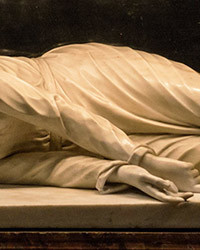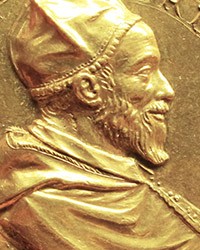He was born in Milan, in an aristocratic family, rich in titles and earthly possessions. His destiny or more appropriately family chose for him a career in the Church, for which he initially prepared in Pavia (Collegio Borromeo) and then in Rome, at the side of the well-known and valued Philip Neri – a charismatic restorer of religious life in the spirit of purity and modesty. His contacts with the Oratorians, a congregation established by Neri at the Church of Santa Maria in Vallicella, influenced the views of the young aristocrat and became a foundation for further activities in the city on the Tiber. It was there, that he established close ties with his uncle Niccolò Sfondrati, at that time a titular cardinal of the Church of Santa Cecilia.
When Camillo was thirty years old, in 1590, his uncle became Pope Gregory XIV while he, overnight, became the papal nepot, the titular cardinal of the Church of Santa Cecilia, the governor of Spoleto, and the legate in Bologna, holding in the palm of his hands numerous Church offices and properties. For ten months, since that is how long the pontificate of his sickly and unable to cope with managing uncle lasted, Camillo became the most important figure at the pope's court.
He was a typical nepot, desiring to centralize power and wealth in the hands of his own family, while his behavior and deeds as his contemporaries pointed out were arrogant but most of all corrupt. His critics noticed, that in truth it was he who was pope, with his uncle simply being at his side. The cardinal nominations which he forced upon Gregory XIV were to strengthen the position of the nepot, after the eventual death of his uncle, whose health worsened daily. And most likely Camillo would have achieved a lot more, had not said death come so rapidly. When this occurred he could only look forward to persecution at the hands of subsequent popes and their nepots, especially since he was accused of defrauding papal finances. The following bishop of Rome, Innocent IX, accused him of ruining the Vatican treasury and threatened him with imprisonment, but fortunately for the cardinal, he died two months later. On the other hand, his successor Pope Clement VIII, destroyed all documents testifying to the financial embezzlement of the cardinal, seeing in the ex-nepot an intellectual and emotional potential that he needed in his struggle for the renewal of religious life, which would define his pontificate. It was necessary to attempt to stimulate religiousness in the spirit of the reforms of the Council of Trent.

From that time the cardinal led a life of prosperity, however, it was ostensibly severe and pious. He was also still a member of the Holy Office, which in the year 1600 condemned Giordano Bruno to death. However, above all, he became a devoted to the pope creator of a new religious policy on the eve of the Jubilee Year of 1600 which was planned with great fanfare. Its principal element was the restoration of the significance of Roman martyrs with particular emphasis placed on female martyrs. In a city filled with immorality, new (in reality old) ideals of womanly virtues were sought. Virginity, deep faith, and the heroism of early-Christian female saints were praised and it was they who as patrons and intercessors were to provide ways of proper behavior. The group of new religious "strategists" also included another cardinal connected with the Oratorians, Cesare Baronio. In a published work entitled Annales Ecclesiastici he carried out a revision of the current (modest) lives of saints, expanding them and accentuating their martyrdom. Another Oratorian, Antonio Gallonio published a book entitled The Tortures and Torments of Christian Martyrs (1591) which included numerous colorful stories about the lives and deaths of early-Christian Romans, among them Saint Cecilia. The archeologist Antonio Bosio, who was also part of the group, created a map of Roman catacombs and the underground with marked locations of the original burial sites of martyrs. Rome was once again to attract pilgrims, with its spiritual force, places marked with sainthood and miracles. A return to grand ceremonies, processions, masses at burial sites of saints, or in the place of storing their relics, encouraged new forms of devotion in which the populace was to partake with euphoria and devotion. The newly awakened cult of the relics was to remind the faithful of their miraculous, healing, and comforting powers and was to become the cure-all for all kinds of problems.
And it was under such circumstances that cardinal Sfondrati, on the 20th October 1599, in the presence of the aforementioned colleagues announced that the corpse of Saint Cecilia had been discovered in the church devoted to her. And this would not have been anything unusual as everyone knew that the coffin with the remains of St. Cecilia had been under the altar since the year 821, when it was moved by Pope Paschal I. What did amaze everybody was the news that her body had remained untouched by the passage of time, and is still beautiful and youthful, as if it had been laid to rest very recently, despite the fact that a thorough description of the contents of the coffin from the times of Paschalis had suggested something entirely different. It was common knowledge that in the IX century the head and some bones had been removed, and placed in other churches. Despite this fact, or perhaps because of it the miracle of the discovery of the saint’s body made waves and the church started to be visited by crowds of pilgrims. And although the corpse itself could not be seen, what the faithful did see was an exquisite marble statue – so perfect, that it seemed that Cecilia, albeit dead, had just been martyred (see: Maderno’s Statue of Saint Cecilia). Sfondrati was the one who commissioned this magnificent, eye-catching, and emotion-stirring artistic work, which qualified as a relic. He was also the first promoter of the work’s creator – Stefano Maderno. For the faithful, it did not matter much, that the story of the saint's remains was incohesive, and it was the same for the cardinal himself, who showing (creating) a true miracle, became a de facto tool of divine Providence, and even the executor of a lofty mission of being the intermediary between Heaven and Earth.

After weeks of preparation, during which Sfondrati celebrated mass at the remains of the saint and prayed until dawn (as witnesses reported), the long-awaited day finally came in the life of the nearly forty-year-old ex-nepot. On the twenty-second of November at ten o'clock, the threshold of his church was crossed by an unending throng of cardinals, bishops, prelates, ambassadors, representatives of the Senate, and aristocrats, followed by Pope Clement VIII himself. A plethora of the faithful had gathered around the church, coming to the Trastevere since dawn, either on foot or in carriages, to pay homage to Saint Cecilia. Musicians also arrived at the church, while a platform was set up in the middle on which the pope was seated, surrounded by his court, celebrating, mass, blessing all, and giving out indulgences. During the ceremony, Cecilia's corpse was once again laid to rest under the church floor. There was no lack of incense, bells, resplendent crimson, carmine, gold, shining satin, and jewels. And if we would have wanted to imagine the power of the papacy, it is here where we could see it firsthand. The event was accompanied by numerous miracles of healing thanks to the saint martyr.
The name of the saintly cardinal was on the lips of all of Rome, while he himself immediately set out to complete another project – a chapel commemorating the death of Cecilia, in the rooms of her own bathhouse (Cappella del Bagno). It is found in the right nave of the church and currently, it is closed to the public by a metal grate. A narrow corridor found behind it leads to a room where the quarters of the family house of Cecilia were to be located. In this way, the cardinal created an additional place of cult, which although was not in any way anchored in history, did have a strong effect on the emotions of the faithful. The cardinal had these rooms decorated with frescoes and paintings completed by his protégée Guido Reni and Paul Bril. He also supervised modernization works in the church itself, which he intended to properly prepare for the Jubilee Year. The frescoes of the apse, entrance, and side walls were renovated, while the walls were also decorated with new paintings. Stairs leading into the crypt were created in the main altar. The crypt contained silver reliquaries and the skulls of other martyrs connected with Cecilia (Valerian, Tiburtius, Maximus as well as popes Urban I and Lucius I.)
The cardinal gave new life both to the church as well as the Benedictine nunnery next to it. The church suddenly became an obligatory destination of pilgrimages for aristocrats, diplomats, as well as simple pilgrims coming to the city on the Tiber, while the nunnery – one of the most prestigious places for those aristocrats and crowned heads of states who wanted to become nuns, among which worth mentioning is Maria Clementina Sobieska. It was also visited by the Queen of Sweden Christina and the Queen of Poland Maria Casimire. A new lease on life was also given to the Trastevere - a region far from the city center overgrown with bushes and meadows and inhabited by poor, undisciplined peoples, who had little interest in religious life.

At the beginning of the XVII century, cardinal Sfondrati became one of the most prominent figures in Rome. The splendor of the miraculous discovery covered him and put him in a position of an (almost) holy knight of Saint Cecilia, to whom he devoted the rest of his life, popularizing her cult. But as it would turn out – not only her. He became an expert at bringing back the significance and glory of female martyrs. The works he supervised in the Church of Sant’Agnese fuori le mura, led to the discovery and a repeated burial of the saint martyr Agnes.
At the age of fifty-eight years old, the cardinal passed away and was buried (in accordance with his wishes), below the altar, next to "his" Cecilia. Five years later, the executors of his will, built a multi-story funerary monument which was to commemorate the dignitary and his deeds. Initially, it was located in the left nave of the church, but now it is situated outside, in the entrance portico.
The cardinal was a well-known collector of relics, but also artistic works. He was seen as an expert on painting and a patron of artists. In 1608 he sold his significant collection to another cardinal and a papal nepot, Scipione Borghese.
If you liked this article, you can help us continue to work by supporting the roma-nonpertutti portal concrete — by sharing newsletters and donating even small amounts. They will help us in our further work.
You can make one-time deposits to your account:
Barbara Kokoska
BIGBPLPW 62 1160 2202 0000 0002 3744 2108
or support on a regular basis with Patonite.pl (lower left corner)
Know that we appreciate it very much and thank You !

